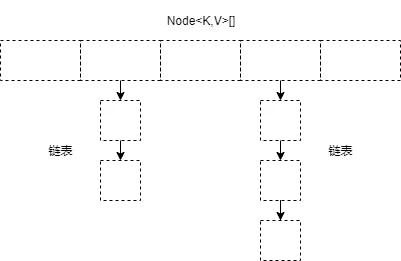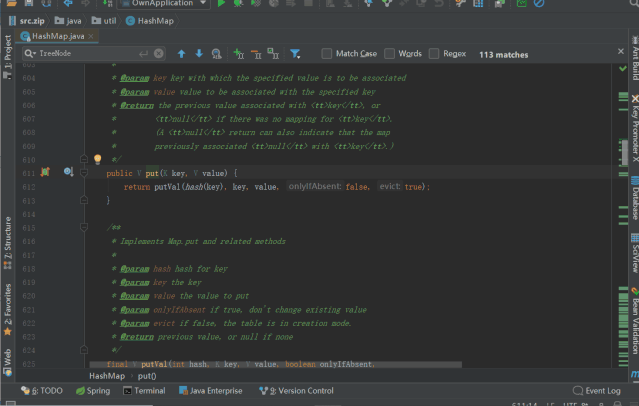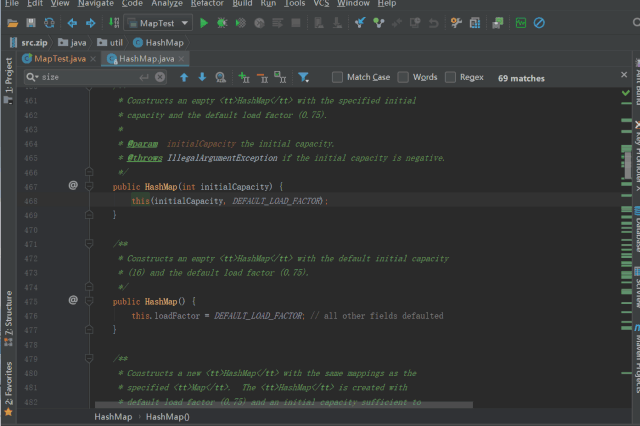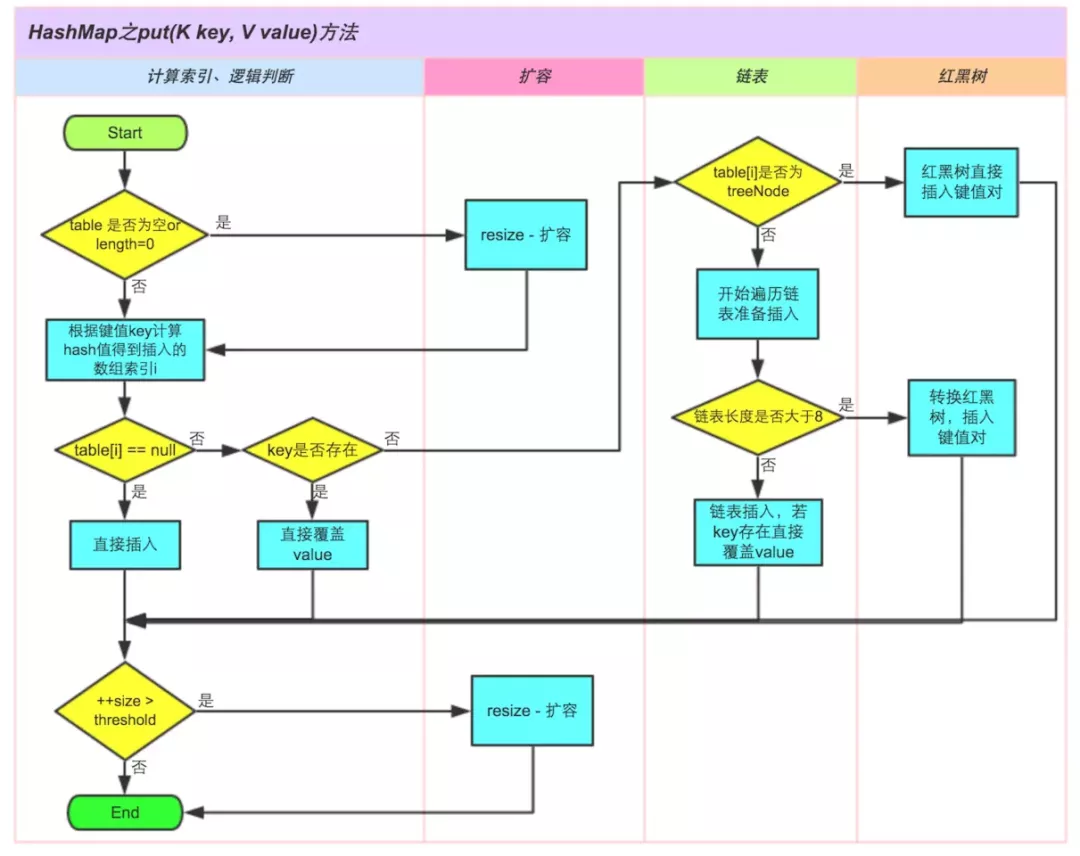Java HashMap
JDK1.8 中 HashMap 的底层实现,底层数据结构 数组 + 链表(或红黑树) ,源码如下
/*** 数组*/transient Node<K,V>[] table;/*** 链表结构*/static class Node<K,V> implements Map.Entry<K,V> {final int hash;final K key;V value;Node<K,V> next;Node(int hash, K key, V value, Node<K,V> next) {this.hash = hash;this.key = key;this.value = value;this.next = next;}public final K getKey() { return key; }public final V getValue() { return value; }public final String toString() { return key + "=" + value; }public final int hashCode() {return Objects.hashCode(key) ^ Objects.hashCode(value);}public final V setValue(V newValue) {V oldValue = value;value = newValue;return oldValue;}public final boolean equals(Object o) {if (o == this)return true;if (o instanceof Map.Entry) {Map.Entry<?,?> e = (Map.Entry<?,?>)o;if (Objects.equals(key, e.getKey()) &&Objects.equals(value, e.getValue()))return true;}return false;}}/*** 红黑树结构*/static final class TreeNode<K,V> extends LinkedHashMap.Entry<K,V> {TreeNode<K,V> parent; // red-black tree linksTreeNode<K,V> left;TreeNode<K,V> right;TreeNode<K,V> prev; // needed to unlink next upon deletionboolean red;...

但面试往往会问的比较细,例如下面的容量问题,能答上来几个?
1、table 的初始化时机是什么时候,初始化的 table.length 是多少、阀值(threshold)是多少,实际能容下多少元素
2、什么时候触发扩容,扩容之后的 table.length、阀值各是多少?
3、table 的 length 为什么是 2 的 n 次幂
4、求索引的时候为什么是:h&(length-1),而不是 h&length,更不是 h%length
5、 Map map = new HashMap(1000); 当存入多少个元素时会触发map的扩容;Map map1 = new HashMap(10000); 存入第 10001个元素时会触发 map1 扩容吗
6、为什么加载因子的默认值是 0.75,并且不推荐修改
问题 1:table 的初始化
HashMap 的构造方法有如下 4 种
/*** 构造方法 1** 通过 指定的 initialCapacity 和 loadFactor 实例化一个空的 HashMap 对象*/public HashMap(int initialCapacity, float loadFactor) {if (initialCapacity < 0)throw new IllegalArgumentException("Illegal initial capacity: " +initialCapacity);if (initialCapacity > MAXIMUM_CAPACITY)initialCapacity = MAXIMUM_CAPACITY;if (loadFactor <= 0 || Float.isNaN(loadFactor))throw new IllegalArgumentException("Illegal load factor: " +loadFactor);this.loadFactor = loadFactor;this.threshold = tableSizeFor(initialCapacity);}/*** 构造方法 2** 通过指定的 initialCapacity 和 默认的 loadFactor(0.75) 实例化一个空的 HashMap 对象*/public HashMap(int initialCapacity) {this(initialCapacity, DEFAULT_LOAD_FACTOR);}/*** 构造方法 3** 通过默认的 initialCapacity 和 默认的 loadFactor(0.75) 实例化一个空的 HashMap 对象*/public HashMap() {this.loadFactor = DEFAULT_LOAD_FACTOR; // all other fields defaulted}/**** 构造方法 4* 通过指定的 Map 对象实例化一个 HashMap 对象*/public HashMap(Map<? extends K, ? extends V> m) {this.loadFactor = DEFAULT_LOAD_FACTOR;putMapEntries(m, false);}
构造方式 4 和 构造方式 1 实际应用的不多,构造方式 2 直接调用的 1(底层实现完全一致),构造方式 2 和 构造方式 3 比较常用,而最常用的是构造方式 3;此时以构造方式 3 为前提来分析,而构造方式 2 则在问题 5 中来分析
使用方式 1 实例化 HashMap 的时候,table 并未进行初始化,那 table 是何时进行初始化的了 ?平时是如何使用 HashMap 的,先实例化、然后 put、然后进行其他操作,如下
Map<String,Object> map = new HashMap();map.put("name", "张三");map.put("age", 21);// 后续操作...
既然实例化的时候未进行 table 的初始化,那是不是在 put 的时候初始化的了,来确认下
resize() 初始化 table 或 对 table 进行双倍扩容,源码如下(注意看注释)
/*** Initializes or doubles table size. If null, allocates in* accord with initial capacity target held in field threshold.* Otherwise, because we are using power-of-two expansion, the* elements from each bin must either stay at same index, or move* with a power of two offset in the new table.** @return the table*/final Node<K,V>[] resize() {Node<K,V>[] oldTab = table; // 第一次 put 的时候,table = nullint oldCap = (oldTab == null) ? 0 : oldTab.length; // oldCap = 0int oldThr = threshold; // threshold=0, oldThr = 0int newCap, newThr = 0;if (oldCap > 0) { // 条件不满足,往下走if (oldCap >= MAXIMUM_CAPACITY) {threshold = Integer.MAX_VALUE;return oldTab;}else if ((newCap = oldCap << 1) < MAXIMUM_CAPACITY &&oldCap >= DEFAULT_INITIAL_CAPACITY)newThr = oldThr << 1; // double threshold}else if (oldThr > 0) // initial capacity was placed in thresholdnewCap = oldThr;else { // zero initial threshold signifies using defaults 走到这里,进行默认初始化newCap = DEFAULT_INITIAL_CAPACITY; // DEFAULT_INITIAL_CAPACITY = 1 << 4 = 16, newCap = 16;newThr = (int)(DEFAULT_LOAD_FACTOR * DEFAULT_INITIAL_CAPACITY); // newThr = 0.75 * 16 = 12;}if (newThr == 0) { // 条件不满足float ft = (float)newCap * loadFactor;newThr = (newCap < MAXIMUM_CAPACITY && ft < (float)MAXIMUM_CAPACITY ?(int)ft : Integer.MAX_VALUE);}threshold = newThr; // threshold = 12; 重置阀值为12@SuppressWarnings({"rawtypes","unchecked"})Node<K,V>[] newTab = (Node<K,V>[])new Node[newCap]; // 初始化 newTab, length = 16;table = newTab; // table 初始化完成, length = 16;if (oldTab != null) { // 此时条件不满足,后续扩容的时候,走此if分支 将数组元素复制到新数组for (int j = 0; j < oldCap; ++j) {Node<K,V> e;if ((e = oldTab[j]) != null) {oldTab[j] = null;if (e.next == null)newTab[e.hash & (newCap - 1)] = e;else if (e instanceof TreeNode)((TreeNode<K,V>)e).split(this, newTab, j, oldCap);else { // preserve orderNode<K,V> loHead = null, loTail = null;Node<K,V> hiHead = null, hiTail = null;Node<K,V> next;do {next = e.next;if ((e.hash & oldCap) == 0) {if (loTail == null)loHead = e;elseloTail.next = e;loTail = e;}else {if (hiTail == null)hiHead = e;elsehiTail.next = e;hiTail = e;}} while ((e = next) != null);if (loTail != null) {loTail.next = null;newTab[j] = loHead;}if (hiTail != null) {hiTail.next = null;newTab[j + oldCap] = hiHead;}}}}}return newTab; // 新数组}
table 的初始化时机是什么时候
一般情况下,在第一次 put 的时候,调用 resize 方法进行 table 的初始化(懒初始化,懒加载思想在很多框架中都有应用!)
初始化的 table.length 是多少、阀值(threshold)是多少,实际能容下多少元素
- 默认情况下,
table.length = 16;指定了initialCapacity的情况放到问题 5 中分析 - 默认情况下,
threshold = 12;指定了initialCapacity的情况放到问题 5 中分析 默认情况下,能存放 12 个元素,当存放第 13 个元素后进行扩容
问题 2 :table 的扩容
putVal 源码如下
/*** Implements Map.put and related methods** @param hash hash for key* @param key the key* @param value the value to put* @param onlyIfAbsent if true, don't change existing value* @param evict if false, the table is in creation mode.* @return previous value, or null if none*/final V putVal(int hash, K key, V value, boolean onlyIfAbsent,boolean evict) {Node<K,V>[] tab; Node<K,V> p; int n, i;if ((tab = table) == null || (n = tab.length) == 0)n = (tab = resize()).length;if ((p = tab[i = (n - 1) & hash]) == null)tab[i] = newNode(hash, key, value, null);else {Node<K,V> e; K k;if (p.hash == hash &&((k = p.key) == key || (key != null && key.equals(k))))e = p;else if (p instanceof TreeNode)e = ((TreeNode<K,V>)p).putTreeVal(this, tab, hash, key, value);else {for (int binCount = 0; ; ++binCount) {if ((e = p.next) == null) {p.next = newNode(hash, key, value, null);if (binCount >= TREEIFY_THRESHOLD - 1) // -1 for 1sttreeifyBin(tab, hash);break;}if (e.hash == hash &&((k = e.key) == key || (key != null && key.equals(k))))break;p = e;}}if (e != null) { // existing mapping for keyV oldValue = e.value;if (!onlyIfAbsent || oldValue == null)e.value = value;afterNodeAccess(e);return oldValue;}}++modCount;if (++size > threshold) // 当size(已存放元素个数) > thrshold(阀值),进行扩容resize();afterNodeInsertion(evict);return null;}
还是调用
resize()进行扩容,但与初始化时不同(注意看注释)/*** Initializes or doubles table size. If null, allocates in* accord with initial capacity target held in field threshold.* Otherwise, because we are using power-of-two expansion, the* elements from each bin must either stay at same index, or move* with a power of two offset in the new table.** @return the table*/final Node<K,V>[] resize() {Node<K,V>[] oldTab = table; // 此时的 table != null,oldTab 指向旧的 tableint oldCap = (oldTab == null) ? 0 : oldTab.length; // oldCap = table.length; 第一次扩容时是 16int oldThr = threshold; // threshold=12, oldThr = 12;int newCap, newThr = 0;if (oldCap > 0) { // 条件满足,走此分支if (oldCap >= MAXIMUM_CAPACITY) {threshold = Integer.MAX_VALUE;return oldTab;}else if ((newCap = oldCap << 1) < MAXIMUM_CAPACITY && // oldCap左移一位; newCap = 16 << 1 = 32;oldCap >= DEFAULT_INITIAL_CAPACITY)newThr = oldThr << 1; // double threshold // newThr = 12 << 1 = 24;}else if (oldThr > 0) // initial capacity was placed in thresholdnewCap = oldThr;else { // zero initial threshold signifies using defaultsnewCap = DEFAULT_INITIAL_CAPACITY; // DEFAULT_INITIAL_CAPACITY = 1 << 4 = 16, newCap = 16;newThr = (int)(DEFAULT_LOAD_FACTOR * DEFAULT_INITIAL_CAPACITY);}if (newThr == 0) { // 条件不满足float ft = (float)newCap * loadFactor;newThr = (newCap < MAXIMUM_CAPACITY && ft < (float)MAXIMUM_CAPACITY ?(int)ft : Integer.MAX_VALUE);}threshold = newThr; // threshold = newThr = 24; 重置阀值为 24@SuppressWarnings({"rawtypes","unchecked"})Node<K,V>[] newTab = (Node<K,V>[])new Node[newCap]; // 初始化 newTab, length = 32;table = newTab; // table 指向 newTab, length = 32;if (oldTab != null) { // 扩容后,将 oldTab(旧table) 中的元素移到 newTab(新table)中for (int j = 0; j < oldCap; ++j) {Node<K,V> e;if ((e = oldTab[j]) != null) {oldTab[j] = null;if (e.next == null)newTab[e.hash & (newCap - 1)] = e; //else if (e instanceof TreeNode)((TreeNode<K,V>)e).split(this, newTab, j, oldCap);else { // preserve orderNode<K,V> loHead = null, loTail = null;Node<K,V> hiHead = null, hiTail = null;Node<K,V> next;do {next = e.next;if ((e.hash & oldCap) == 0) {if (loTail == null)loHead = e;elseloTail.next = e;loTail = e;}else {if (hiTail == null)hiHead = e;elsehiTail.next = e;hiTail = e;}} while ((e = next) != null);if (loTail != null) {loTail.next = null;newTab[j] = loHead;}if (hiTail != null) {hiTail.next = null;newTab[j + oldCap] = hiHead;}}}}}return newTab;}
自此,问题 2 的答案也就清晰了
什么时候触发扩容,扩容之后的 table.length、阀值各是多少当 size > threshold 的时候进行扩容
- 扩容之后的 table.length = 旧
table.length * 2, - 扩容之后的 threshold = 旧
threshold * 2问题 3、4 :2 的 n 次幂
table 是一个数组,那么如何最快的将元素 e 放入数组 ?当然是找到元素 e 在 table 中对应的位置 index ,然后table[index] = e;就好了;如何找到 e 在 table 中的位置了 ?
只能通过数组下标(索引)操作数组,而数组的下标类型又是 int ,如果 e 是 int 类型,那好说,就直接用 e 来做数组下标(若 e > table.length,则可以 e % table.length 来获取下标),可 key - value 中的 key 类型不一定,所以需要一种统一的方式将 key 转换成 int ,最好是一个 key 对应一个唯一的 int (目前还不可能, int有范围限制,对转换方法要求也极高),所以引入了 hash 方法
实现 key 到 int 的转换。拿到了 key 对应的 int h 之后,最容易想到的对 value 的 put 和 get 操作也许如下 ```java // putstatic final int hash(Object key) {int h;return (key == null) ? 0 : (h = key.hashCode()) ^ (h >>> 16); // 这里的处理,有兴趣的可以琢磨下;能够减少碰撞}
table[h % table.length] = value;
// get
e = table[h % table.length];
直接取模是最容易想到的获取下标的方法,但是最高效的方法吗 ?<br />计算机中的四则运算最终都会转换成二进制的位运算<br /><br />可以发现,只有 & 数是1时,& 运算的结果与被 & 数一致```java1&1=1;0&1=0;1&0=0;0&0=0;
这同样适用于多位操作数
1010&1111=1010; => 10&15=10;1011&1111=1011; => 11&15=11;01010&10000=00000; => 10&16=0;01011&10000=00000; => 11&16=0;
是不是又有所发现:10 & 16 与 11 & 16 得到的结果一样,也就是冲突(碰撞)了,那么 10 和 11 对应的 value 会在同一个链表中,而 table 的有些位置则永远不会有元素,这就导致 table 的空间未得到充分利用,同时还降低了 put 和 get 的效率(对比数组和链表);由于是 2 个数进行 & 运算,所以结果由这两个数决定,如果把这两个数都做下限制,那得到的结果是不是可控制在想要的范围内了 ?
需要利用好 & 运算的特点,当右边的数的低位二进制是连续的 1 ,且左边是一个均匀的数(需要 hash 方法实现,尽量保证 key 的 h 唯一),那么得到的结果就比较完美了。低位二进制连续的 1,很容易想到 2^n - 1; 而关于左边均匀的数,则通过 hash 方法来实现,这里不做细究了。
自此,2 的 n 次幂的相关问题就清楚了
table 的 length 为什么是 2 的 n 次幂
求索引的时候为什么是:h&(length-1),而不是 h&length,更不是 h%length
h%length效率不如位运算快h&length会提高碰撞几率,导致 table 的空间得不到更充分的利用、降低 table 的操作效率问题 5:指定
initialCapacity当指定了
initialCapacity,HashMap的构造方法有些许不同,如下所示
调用 tableSizeFor 进行 threshold 的初始化/*** Returns a power of two size for the given target capacity.* 返回 >= cap 最小的 2^n* cap = 10, 则返回 2^4 = 16;* cap = 5, 则返回 2^3 = 8;*/static final int tableSizeFor(int cap) {int n = cap - 1;n |= n >>> 1;n |= n >>> 2;n |= n >>> 4;n |= n >>> 8;n |= n >>> 16;return (n < 0) ? 1 : (n >= MAXIMUM_CAPACITY) ? MAXIMUM_CAPACITY : n + 1;}
虽然此处初始化的是 threshold,但后面初始化 table 的时候,会将其用于 table 的 length,同时会重置 threshold 为
table.length * loadFactor
自此,问题 5 也就清楚了Map map = new HashMap(1000);当存入多少个元素时会触发map的扩容此时的
table.length = 2^10 = 1024;threshold = 1024 * 0.75 = 768;所以存入第 769 个元素时进行扩容Map map1 = new HashMap(10000);存入第 10001个元素时会触发 map1 扩容吗此时的
table.length = 2^14 = 16384;threshold = 16384 * 0.75 = 12288;所以存入第 10001 个元素时不会进行扩容问题6:加载因子
为什么加载因子的默认值是 0.75,并且不推荐修改
如果loadFactor太小,那么map中的table需要不断的扩容,扩容是个耗时的过程
- 如果loadFactor太大,那么map中table放满了也不不会扩容,导致冲突越来越多,解决冲突而起的链表越来越长,效率越来越低
- 而 0.75 这是一个折中的值,是一个比较理想的值
总 结
1、table.length = 2^n,是为了能利用位运算(&)来求 key 的下标,而 h&(length-1) 是为了充分利用 table 的空间,并减少 key 的碰撞
2、加载因子太小, table 需要不断的扩容,影响 put 效率;太大会导致碰撞越来越多,链表越来越长(转红黑树),影响效率;0.75 是一个比较理想的中间值
3、table.length = 2^n、hash 方法获取 key 的 h、加载因子 0.75、数组 + 链表(或红黑树),一环扣一环,保证了 key 在 table 中的均匀分配,充分利用了空间,也保证了操作效率,环环相扣的,而不是心血来潮的随意处理;缺了一环,其他的环就无意义了!
4、put 方法的流程图画

